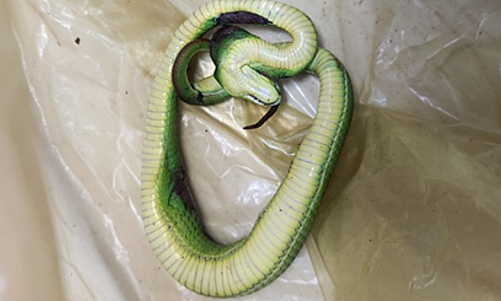The boy's family stopped the bleeding and captured the snake, bringing both to a local hospital. The boy received initial first aid and fluids before being transferred to TP HCM overnight.
On 16/7, Doctor Nguyen Minh Tien, Deputy Director of the Children's Hospital of TP HCM, reported that the boy's big toe and foot were bruised and swollen, with blood soaking through the bandages. Tests revealed a severe blood clotting disorder, a symptom of bites from snakes of the Viperidae family. The snake brought in by the family was identified as a red-tailed green ratsnake.
Doctors administered antivenom specific to the red-tailed green ratsnake. With no improvement after six hours, a second dose was given. After 12 hours, the bleeding stopped, and the swelling and bruising subsided.
 |
The snake captured by the family. Photo: *Provided by doctor* |
Doctor Tien advised parents to clear vegetation around their homes to prevent snakes, bees, and insects from entering and harming children, especially during the rainy season. He also recommended caution when walking in grassy or wooded areas where venomous snakes might be present. Wearing boots while working in fields and gardens is crucial, avoiding walking barefoot and climbing trees where there's a risk of being bitten by snakes or falling.
In case of a snake bite, wash the wound with soap and water, and apply a cool compress to reduce pain and swelling. Wrap a clean cloth or bandage above the bite and immediately transport the victim to a medical facility for appropriate antivenom treatment. Prompt first aid and the correct antivenom are vital in managing snake bites.
Cutting, squeezing, or sucking the wound to remove venom is not recommended. Avoid applying leaves to the wound as they can cause infection and tissue damage. Incorrect first aid can harm the victim, potentially leading to limb amputation or even death if treatment is delayed.
Le Phuong












